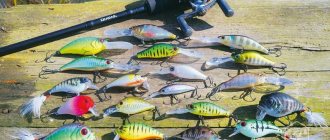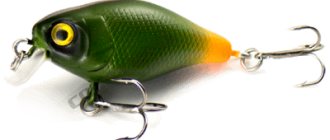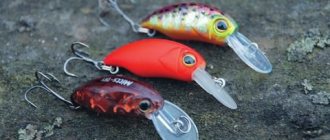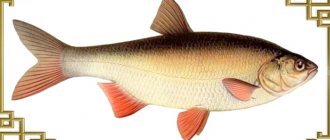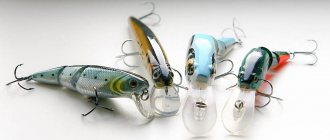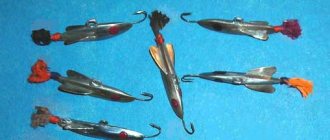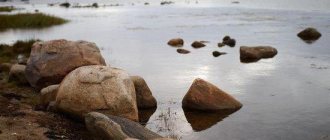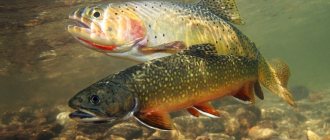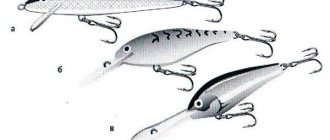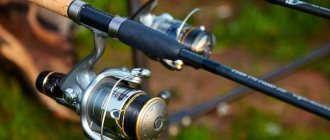A wobbler is a voluminous bait made of wood or plastic that is used for fishing with spinning or trolling.
Translated from English wobbler
means to swing, move, waddle. Indeed, the wobbler imitates with its play a wounded, fleeing fish, which rolls from side to side, staggers and sways, thereby attracting a predator.
In English, anglers use the terms “crankbait”, “minnow” and “hard bait” to refer to wobblers.
In the article we will try to understand the classification of wobblers by shape, degree of buoyancy and depth, we will describe the main wiring of wobblers and methods of attaching wobblers to the fishing line, and give advice on choosing a wobbler for fishing conditions.
Story
The first prototype of the future modern wobbler was created in 1894 by the American beekeeper James Haddon. One day, Haddon was whittling boards for his apiary on the shore of the lake and threw the shavings into the water. Just as he was about to leave for home, he noticed that American largemouth bass (bass) were greedily grabbing wood shavings floating with the current.
The first wobbler created by Haddon resembled a frog in appearance. After this incident, Haddon experimented with making various wooden fishing lures for 8 years, and in 1902 he received a patent for a new fishing lure called the Slopenose Dowagiac Expert.
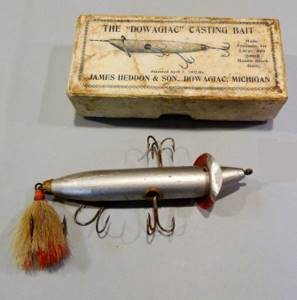
Also in 1902, James Heddon and Son, Co. was founded. Which began to produce fishing lures. The Dowagiac Expert wobbler and subsequent wobblers produced by Haddon enjoyed great commercial success. In 1932, James Heddon and Son, Co. The world's first plastic wobbler was manufactured, called Spook, which translates as a ghost, so named because of its transparent body.

Finnish fisherman Lauri Rapala played a major role in creating the modern type of wobbler. In 1936, he made his first wobbler, which is still produced today under the name Rapala Original Floater. Lauri Rapala's merit lies in the fact that he was the first in the world to make a wobbler with a blade, which makes the wobbler oscillate and go to a certain depth. The Rapala company, created by Lauri Rapala, is today one of the largest manufacturers of fishing lures in the world.
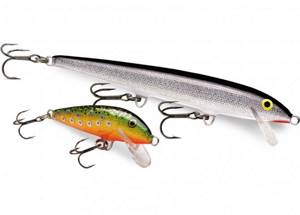
Over time, more and more wobbler manufacturers began to make their lures from plastic rather than wood. But wobblers made of wood have not ceased to exist; they are still produced and still occupy their well-deserved places in the boxes of spinners.
Lures consisting of two or three parts
There is a separate type of wobblers, the main difference of which is that their body consists of two or more parts, movably connected to each other. They are often called "Jointed" . Such wobblers also have their own types and a certain classification, which takes into account their appearance and, sometimes, the material of manufacture.

For example, baits that are made of soft materials are called “SwimBait” .
There is an interesting class of baits, which includes all components that imitate various insects, crustaceans or frogs, and is designated “Cicada” . These types of wobblers and their properties are carefully studied in practice by experienced fishermen who know the behavioral characteristics of crustaceans or insects that this bait imitates. At the same time, sometimes the color of the wobbler is very important.
Design
The wobbler, with its design and appearance, imitates the hunting objects of various predatory fish: a fish, a frog or an insect and should provoke the predator to attack. The reason for the attack of a wobbler by a predator can be either the desire to eat it or to protect its territory from foreign invasion.
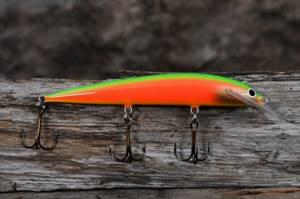
The design of a typical wobbler consists of the following components:
- Housings
- Blades
- Kryuchkov
- Loops for attaching fishing line
Frame
The body of the wobbler can be made of wood or plastic. To make wobblers from wood, they use: balsa, pine, hazel or oak. To make a wobbler from plastic, use: ABC plastic, polystyrene, polycarbonate or expanded polystyrene. Depending on the plastic used, the body of the wobbler can be either hollow inside or solidly cast.

The wobbler body most often has the shape of a fish or other food items of predatory fish, such as frogs, crustaceans and insects.
The body of the wobbler should not only be similar in its shape and overall appearance to the live food of a predator, but also have such ballistic and aerohydrodynamic characteristics as to be both stable in water and have good flight qualities in the air.
The body of the wobbler can be either monolithic or consisting of several (two, three) parts. A wobbler consisting of several parts is more mobile in water; such wobblers are called compound wobblers.
To strengthen the body of the wobbler, a frame made of metal wire can be installed inside it, at one end of which there is a loop for tying fishing line, and at the other ends there are loops for attaching hooks.
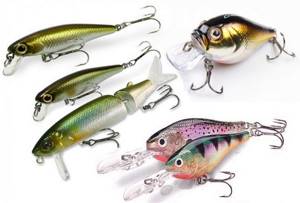
Noise chambers can be placed inside the wobbler body, inside which balls made of metal, glass or plastic can be placed. When the wobbler moves underwater, the balls move inside the noise chamber, creating an additional acoustic effect that attracts predators.
Inside the wobbler body there can also be a long-distance casting system, which has different names among different wobbler manufacturers. The long-distance casting system is a channel through which the weight moves. In the normal state, the weight is held by a magnet in the front part of the channel; when casting, the weight is detached from the magnet and shifted to the tail of the bait, thereby shifting the center of gravity of the wobbler, which increases the range and accuracy of the wobbler's flight. After the wobbler falls into the water, the weight is again fixed with a magnet in the front part of the channel, without interfering with the play of the wobbler.
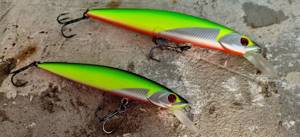
The body of the wobbler can be painted in the natural colors of the real prey of predators, or it can be painted in fantasy colors that provoke the predator to attack. Many wobblers have a holographic coating on the surface of the body, which increases the attractiveness of the bait to a predator.
Tungsten balls can act as a wobbler load. The weight creates the correct position of the wobbler in the water, provides the desired buoyancy, complements the play of the wobbler and gives it sound effects in the form of noise.
Wobbler blade
According to their design, all wobblers are divided into bladed and bladeless. Bladed wobblers have a special blade in their front part, which causes the wobbler to oscillate and go deep to a certain depth. Currently, the blades on most wobblers are made of transparent plastic, unnoticeable to predators, although there are models of particularly powerful wobblers on which metal blades are installed to increase strength.
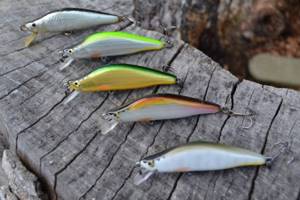
The wobbler blade has four main parameters:
- Length
- determines the depth at which the wobbler will work; the longer the blade, the deeper the wobbler works. A wobbler with a long blade can be thrown from side to side and even thrown to the surface, so the line loop for a wobbler with a long blade is placed in the middle of the blade, thereby increasing the stability of the bait. - Tilt
- determines the degree of intensity of the wobbler's play. The closer the inclination of the wobbler blade is to perpendicular, relative to the movement of the wobbler, the more intense the wobbler’s play will be. As the angle of inclination decreases, the intensity of the game decreases. - Area
also determines the intensity of the wobbler's play. Scientifically speaking, the intensity of the wobbler's play is determined by the projection of the area of the wobbler's blade perpendicular to the flow plane. As a rule, the wider the wobbler blade, the more intense its play. - Configuration
- determines the nuances of the behavior of the wobbler; often the blade is made slightly concave or with a slight depression.
Hook
Most wobblers are equipped with three-hook hooks and tees. The smallest wobblers have only one hook, medium-sized wobblers have two hooks, large wobblers are equipped with three hooks, the largest wobblers can sometimes be equipped with even four hooks.
You may be interested in: Retractable leash
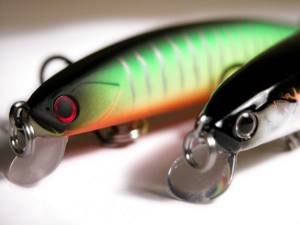
Some wobblers from individual manufacturers can be equipped with double hooks or single hooks. Wobblers designed for catching fish using the catch-and-release principle are equipped with single hooks without barbs, as they cause minimal damage to the fish.
On some wobblers, the hooks can be additionally decorated with feathers or synthetic materials, which, in some fishing conditions, increases the attractiveness of the bait for a predator.
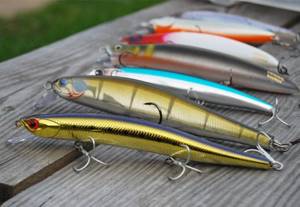
The total weight of the hooks installed on the wobbler affects the buoyancy of the wobbler; by installing lighter or heavier hooks on the wobbler, you can turn a floating wobbler into a sinking one and vice versa.
Fastening
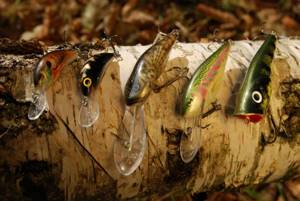
To attach the wobbler to the fishing line, the wobbler has a special wire loop, which can be located both in the bow of the bait and on the blade of the wobbler. The fishing line is attached to the wobbler's loop either through a carabiner with a swivel, or through a special loop knot. A carabiner with a swivel can influence the balancing of the wobbler and its play, and this influence is greater, the smaller the mass of the wobbler in relation to the mass of the carabiner with a swivel.
What is a “wobbler”?
This is a hard bait, most often made of plastic in the shape of a fish. Any wobbler consists of a body, a blade, hooks and a wire loop. Attracts predators because it looks like easy prey. Thanks to a special ball in the bait, it makes an attractive sound for fish. It costs more than silicone baits, but it is important to consider that the wobbler will last much longer. Moreover, in some wiring, the wobbler does not even need to be twitched; its game will do everything itself, unlike silicone baits, which need to be constantly animated. Wobblers are more functional than natural baits. However, now there are a huge number of products on the market and it is very difficult to understand how they differ from each other. That is why we have prepared instructions for choosing wobblers.
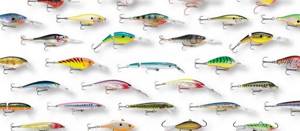
Blade wobblers
Minnow
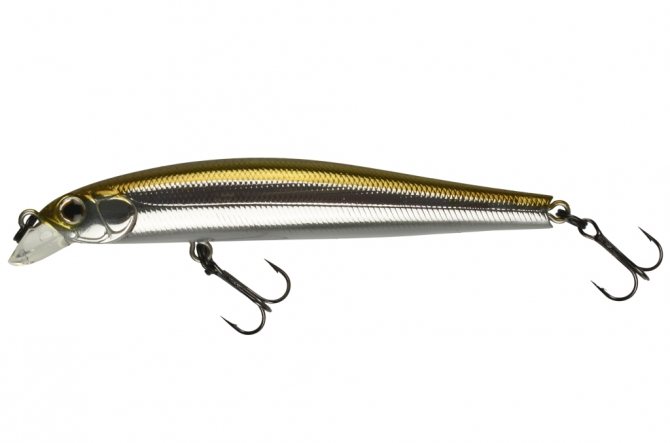
Minnows are wobblers of a purlin shape, with a convex back, the body of the wobbler smoothly tapers towards the tail. Minnow wobblers resemble the shape of a narrow-bodied fry.
with a convex back, an elongated and rounded body shape that tapers at the tail.
The blade is usually small, located at an average angle to the body of the wobbler. They have a rather weakly expressed game of their own. They are considered the most catchy wobblers for pike.
The name minnow wobblers comes from the word minnow, which translated from English means minnow fish. The minnow is a small fish similar to a minnow, reaching a weight of 100 grams and a length of 15 cm.
The popularity of minnow wobblers is explained by their good catchability and the ability for a spinner to experiment with different fishing patterns.
Minnows are produced with varying degrees of buoyancy and depth of penetration. Some of the most interesting minnow wobblers are suspenders, wobblers that have neutral buoyancy. Using a suspender, an angler can successfully fish all depths of a reservoir. An angler can independently make a suspended wobbler into a sinking or floating wobbler by placing heavier or lighter hooks on the wobbler.
Minnow wobblers with a length of 50 to 70 mm are best suited for catching perch. The best minnow size for catching pike is a wobbler with a length of 70 to 130 mm. For catching pike perch, a minnow with a length of 70 to 90 mm is suitable.
Fishing with a minnow wobbler requires the angler to have good skills in handling a spinning rod and good command of various fishing techniques.
The minnow wobbler, thanks to the presence of a blade, has its own game and can work with uniform wiring. But the full potential of the minnow is revealed when using jerk wiring, the so-called twitching. When jerking, it is very important to observe pauses, since most attacks by predators occur precisely during them. The jerk attracts the predator's attention to the bait, and the pause gives him the opportunity to catch up with the bait and attack it.
Shad
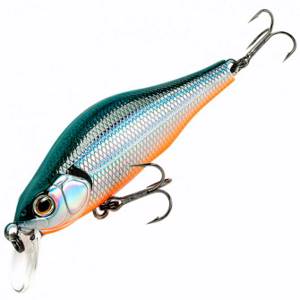
Shad wobblers have a laterally flattened, high body. The name of the wobbler comes from the English word shad, which means a fish that resembles a herring. The shape of the wobbler's body really resembles a sled or roach.
Shad wobblers can be either floating or sinking, both designed for fishing in shallow water and for fishing in deep water.
Shad wobblers are primarily designed for catching perch; pike and pike perch, as a rule, are much worse caught with them. Therefore, it makes no sense to buy a large shad wobbler. The optimal size of a shad wobbler is a wobbler with a length of 40 to 70 mm.
Shad wobblers do not have their own bright game, so they require the angler to master different fishing techniques. Due to the flat shape of shad wobbler baits, they do not have the best flight qualities, so it makes sense to choose wobblers equipped with a long-distance casting system. Due to the shape of the bait, shad have high water resistance when retrieving, so to fish with this wobbler, you need to choose the right spinning rod.

Shad behaves well in the current, holds the stream well when other wobblers, under the same conditions, are thrown to the surface. In still water, shad work on any type of retrieve: both uniform and stop-and-go and twitching.
Shad wobblers are a specific type of wobbler and it is not recommended for a novice spinning angler to purchase them, because for them there are more interesting types of wobblers that make sense to master first.
Crank
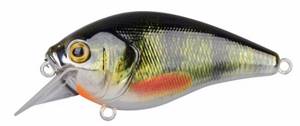
The crank wobbler has a wide, convex, laterally flattened oval body that resembles a drop. Crank is a transitional form between shad and fat wobblers; in its appearance it is somewhat reminiscent of crucian carp. The name crank comes from the English word crank, which means swinging. Crank has his own active game.
Initially developed abroad for catching bass and trout, in our conditions it catches well perch, trout and chub, due to the high-frequency vibrations created by the wobbler.
Crank wobblers can be either floating or sinking, both designed for fishing in shallow water and for fishing in deep water. Cranks work great both in still water and in currents. The cranks, even when working in the current and at high speeds, do not lose their play, while creating high-frequency vibrations that attract predators. With even wiring, the crank, with its rattling, imitates the convulsions of a wounded fish.
Cranks have good flight qualities due to their compact size and fairly heavy weight. Most crank wobblers have lengths from 50 to 80 mm and weight up to 10 grams.
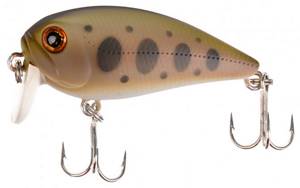
Many cranks have noise chambers in their design, with balls located in them, which create an additional acoustic effect when guiding the wobbler. For fishing in cloudy weather conditions and when fishing in muddy water, cranks of bright, acidic colors show good results.
Floating cranks are often used for drift fishing; for this, after casting a wobbler, it is given the opportunity to float downstream to the place of interest to the angler, then the reel bail closes and the angler begins reeling in the fishing line. This fishing method is convenient for catching shy fish (trout, chub), and can also be used in places where the shore does not allow regular bait casting.
You may be interested in: Ide
Thanks to the presence of their own game, crank wobblers are easily mastered by beginning spinners.
Fat
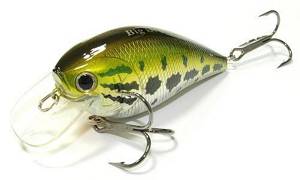
The fat wobbler has an inflated, drop-shaped body. The name fat comes from the English word fat, which means thick, fat.
Fat wobblers, due to their round shape, have good flight qualities. Typically, fats are produced with a small, fairly wide blade and have a depth of no more than 1.5 meters. Fat wobblers have their own active game, which is reminiscent of a heavyweight waddling from side to side. The action of the fat wobbler is high-frequency with a wide amplitude.
Many fats have noise chambers inside their body, with balls located in them, which create an acoustic effect when guiding the wobbler, which attracts the attention of a predator.
Fats work well on the most common uniform wiring. When fishing with them, you can also use all kinds of pauses, jerks and pulls, thereby introducing variety into the behavior of the wobbler.
Fat wobblers are the main bait for catching chub; they cope well with catching trout, ide, and perch.
Fats are used when catching active predators or fish that feed in the upper layers of water. Fats can also be used for fishing in the surface layer of a reservoir, when underwater vegetation prevents the use of deeper-reaching baits.
Fat wobblers are well suited for beginner spinning anglers, as they do not require mastery of complex techniques for retrieving the bait.
Minnow
The first wobbler, invented by L. Rapala in 1936, was a minnow. This type is very popular among anglers. The reason for this is their functionality and diversity.
Structurally, they are an elongated “fish” imitating a fry, small in width, shaped like a circle when cut, and most often equipped with two tees. The shape of the blade, weight and dimensions determine its buoyancy. In order to catch perch, you need to use a small minnow up to 10 cm. For pike, large wobblers, 10 to 14 cm long, are suitable.
The main types of postings used are twitching and “Stop and Go”. During “research” fishing, sinking minnows are used. There are swimmers who demonstrate their own interesting game even when the thread is calmly maintained. These are useful to use in clean water in sunny weather on a predator walking near the surface.
The bulk of the baits in this group are “suspending” baits, equipped with a small “blade” at an angle of 45˚, having average buoyancy and not demonstrating individual movement. The depth of minnow wobblers is up to 2.5-3 m. An interesting feature is the ability of those equipped with balls inside to lure deep-sea fish.
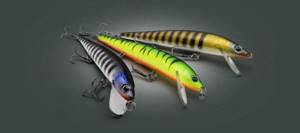
Bladeless wobblers
Popper
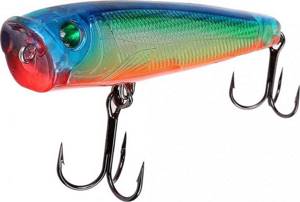
The popper is a surface bladeless wobbler. There is a notch in the nose of the popper that makes a loud gurgling sound when jerked. Used for catching predatory fish in open areas of water bodies overgrown with underwater vegetation. The main method of wiring is twitching, jerking. During jerking, the wobbler should produce a gurgling sound characteristic of a popper.
Walker
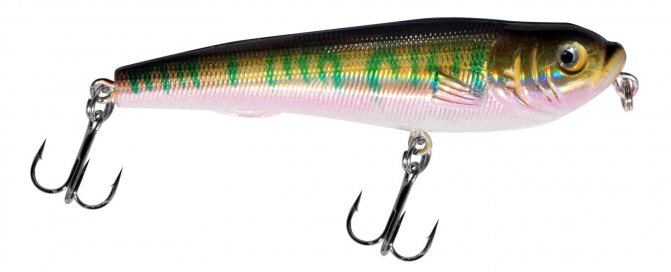
The Walker is a surface wobbler without a blade. The walker is guided in a “dog-walking” style, called “herringbone” by some spinners.
Hydroplane
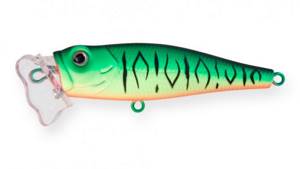
The glider is a surface wobbler with a special forked blade. Designed for catching predators in water bodies overgrown with aquatic vegetation.
Jerkbait
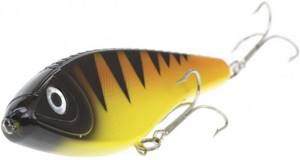
A jerkbait is a heavy and large bladeless wobbler, slightly flattened on the sides. Animated by jerky wiring. Jerkbaits can be fished in both shallow and deep water.
Swimbait
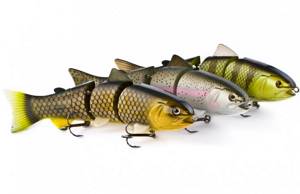
A swimbait is a bladeless wobbler consisting of several parts. The swimbait is designed for fishing with both uniform and jerking retrieves in shallow and medium-depth areas.
Stickbait
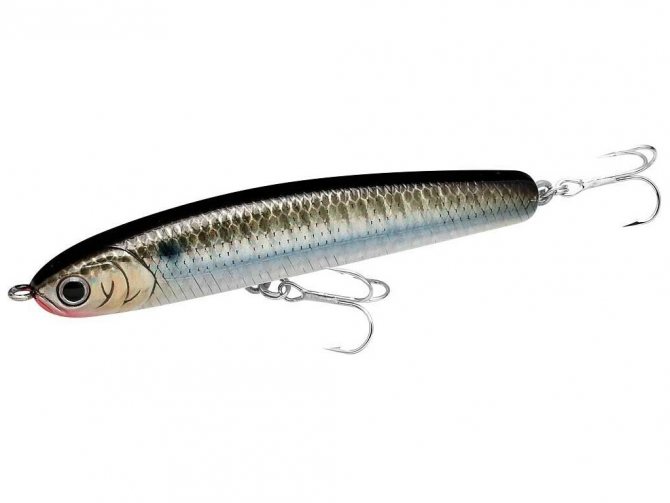
A stickbait is a sinking bladeless wobbler designed for fishing in the upper layers of water. Also called flasher and jumper. The stickbait glides across the water surface, leaving behind whiskers and air bubbles, which attracts predators. Stickbaits are especially effective when fishing in weedy areas and in windy conditions.
Rattlin
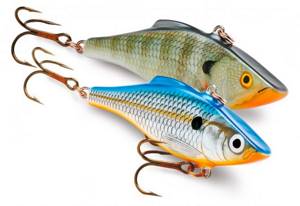
Rattlin is a sinking bladeless wobbler, very flat on the sides, most often with a rattle inside. Some manufacturers also call rattlins by other names: lipless crankbaits, vibration (vib). A special feature of the rattlin is the way it is attached to the fishing line; the rattlin is attached to a loop located on the back of the wobbler's head. Rattlin has a very active game. Rattlins are designed for catching active predators in deep water areas.
Crowler
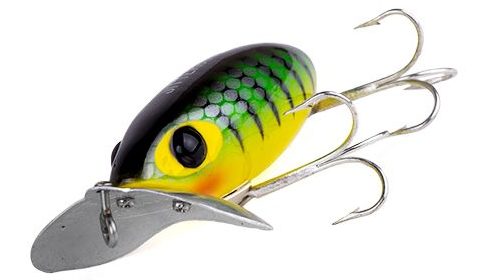
The crawler is a bladeless wobbler that moves in the water with a slurping sound. Designed for catching predators in overgrown reservoirs with standing water. The optimal depth at the fishing site is 1.5 meters.
Darter
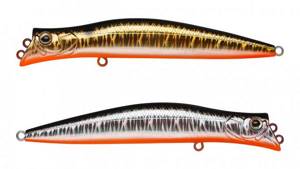
A darterre is a long and narrow bladeless wobbler. Has low frequency play. Simulates a feeding fish.
Wobblers Zip Baits - review of popular models
What does the ideal modern bait look like, making it easier for a fisherman to hunt a predator? This is a wobbler - it is made of plastic, and in external parameters it is very similar to a fish, because its task is to lure a large, predatory inhabitant of the water surface, it can be small fish - ide, sabrefish, roach, trout, perch or larger prey (pike and catfish).
In our article we will describe and review the most catchy wobblers of the Japanese company Zip Baits: rigge, bait, khamsin, orbit, trigger.
READ Fishing soup: recipes
Classification of wobblers by degree of buoyancy
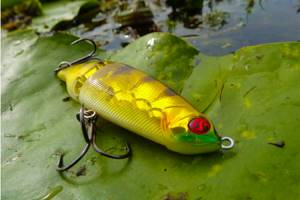
One of the most important parameters for a wobbler is the degree of its buoyancy. According to the degree of buoyancy, all wobblers are divided into three large groups:
- floating
- neutral buoyancy (suspenders)
- Sinking
When the fishing line is reeled in, a floating wobbler sinks to a certain depth, and when the reeling stops, it pops up.
Floating wobblers are divided into two subgroups:
- strongly floating (FF - Fast Floating)
- weakly floating (SF - Slow Floating)
Wobblers of these two subgroups differ in the speed with which they float up when the line reeling stops. Strongly floating wobblers (FF) float up quickly, while weakly floating wobblers (SF), which include most wobblers, float up at an average speed.
Recently, some manufacturers have introduced additional gradations of wobbler buoyancy, so two additional categories of floating wobblers have appeared:
- very slow floating – SSF (Super Slow Floating)
- very fast floating – SFF (Super Fast Floating)
Floating wobblers have two important advantages for fishermen: floating wobblers can be floated downstream and with the help of floating wobblers you can effectively bypass underwater obstacles.

Sinking wobblers are divided into two subgroups:
- fast sinking (FS - Fast Sinking)
- slowly sinking (SS - Slow Sinking)
Wobblers of these subgroups differ in the speed at which they sink. Slow-sinking wobblers (SS), which include most sinking wobblers, go at a certain depth when reeling in, and after reeling stops they begin to sink. Fast-sinking wobblers (FS), when the reeling stops, they sink very quickly; most wobblers intended for fishing at great depths belong to this type of wobblers.
Recently, additional subcategories have appeared:
- very slow sinking – SSS (Super Slow Sinking)
- very fast sinking – SFS (Super Fast Sinking)
Sinking wobblers have an important advantage for the fisherman; they are quite heavy for their size, so they have a good range.
Wobblers with neutral buoyancy (suspenders) do not sink or float in the water; they seem to be suspended. The name suspender comes from the English word suspend, which translates as suspended, weighing. Suspenders are most often designated "SP" or "SU".
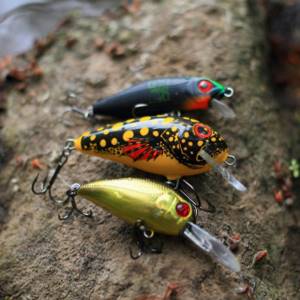
A spinner needs to understand that there is no ideal suspender that would hang in the water column. The neutral buoyancy of a wobbler can be affected by a large number of factors, including the weight of the line, the weight of the hooks and even the temperature of the water. Some wobbler manufacturers even indicate on their wobblers the water temperature at which they will be neutrally buoyant. Most often, suspenders either sink very slowly or float very slowly.
For an angler fishing with a wobbler, you need to choose the right wobbler for specific fishing conditions. The choice of a wobbler based on the degree of buoyancy depends on many factors: the depth of the reservoir, the presence of underwater vegetation and snags at the bottom of the reservoir, as well as at what depth the predator is standing. For example, you should not use sinking wobblers in reservoirs where there are a large number of snags at the bottom.
Jerkbaits
When thinking about how to choose wobblers, you need to take a closer look at jerkbaits. These products are large and heavy, so most of them are created as “sinking” ones. The model has no blades.
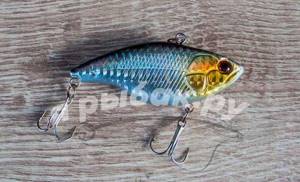
The most popular today are three types of bait presented:
- Glider. This product can instantly deviate from the trajectory that was set before. It is advisable to use it at shallow depths - up to two meters.
- Pulbait. These products are no different in mobility. Immediately after the jerk, the bait dives into the water, and then after a while it slowly begins to emerge. It’s good to catch pike with such elements.
- Twitchbait. These wobblers have blades, but they are small. Thanks to this, the bait swings not only when a jerk is made, but also when in a calm state.
Classification of wobblers by depth
Wobblers differ in several classes according to the degree of depth. The depth of the wobbler tells the angler how deep from the surface of the water the wobbler will be when the angler reels in the fishing line.
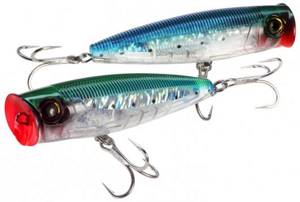
- Surface - also called top waters, as the name itself suggests, wobblers of this type do not go deep at all, they work on the very surface of the water; this class of wobblers includes: poppers, walkers, crawlers. Topwater lures can be super effective in certain fishing conditions.
- Subsurface - also called super shallow runners, designated SSR, dive to a depth of no more than 10-15 cm. They can be very effective when catching predatory fish above a carpet of algae.
- Shallow water - also called shallow runners, designated SR, as a rule, they are buried to a depth of no more than 1 meter. The most versatile of all wobblers, suitable for most fishing conditions.
- Medium submersible
- also called medium runners, designated MR, buried to a depth of 1.5 meters. - Deep-sea - also called deep runners, designated DR, have a depth of up to 1.5-2 meters. Anglers call them deep wobblers. Designed for fishing in deep places.
- Medium deep water
- also called medium deep runners, designated MDR, buried to a depth of 3 meters. - Super-deep-water - often designated DDR, such wobblers are capable of going deep to a depth of 3-4 meters or more. Not very often used in spinning, but very often used for trolling. They are easy to recognize by their appearance; they have a very large, long blade in front.
You may be interested in: Asp
The correct choice of wobbler in terms of depth is the basis for successful fishing and a decent-sized catch.
A wobbler that is incorrectly selected in terms of depth or completely ignoring this parameter when fishing leads to unsuccessful fishing.
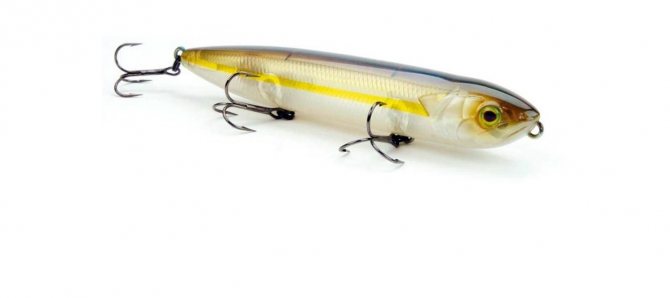
Let's give a simple example:
a fisherman catches a low-active pike in a reservoir whose depth at the fishing site is 2.5-3 meters, while he uses a wobbler with a depth of SSR of up to 0.5 meters. The pike stands in a shelter, either at the very bottom or near it, and since it is in a passive state, it will not pursue a wobbler walking half a meter from the surface, that is, at least 2 meters from it. As a result, fishing was unsuccessful. For these fishing conditions, the angler needs to use a wobbler with a depth of MR or MDR, going at a depth of up to 1.5 meters or at a depth of up to 3 meters, respectively.
Shed-type wobblers: features, types
Today, various manufacturers offer two types of these baits:
drowning; suspenders; floating. If you need to fish bottom areas, it is recommended to choose models with a large blade. The advantage of the bait is that it quickly reaches the dive level, this was made possible thanks to the vertical trajectory of the dive.
These baits are suitable for fishing at a depth of up to 4 meters; above that they may not cope with the tasks. It is recommended that the wiring be uniform; we note that the load on the rod is high when wiring, so the tackle should be rigid.
The Jackall Soul Shad is perfect for fishing in calm water at a depth of up to 2 meters; the model is available in various colors. This bait, like others, is designed for catching trophy ide.
Wiring wobblers
Retrieving refers to the actions of a fisherman performed with a reel and rod, which force the bait to move in the water at a certain speed and along a certain trajectory, with its movements reminding the predator of a food object.
Uniform wiring
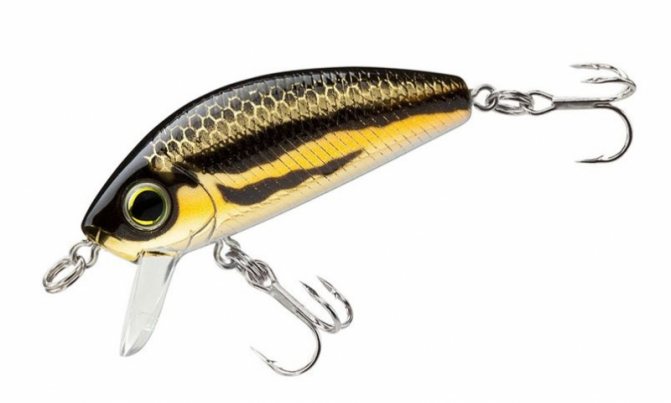
Uniform wiring is the simplest and most common type of wiring. Uniform wiring is created by constant rotation of the coil. The rod is not involved in wiring. Only lures that have their own game work on a uniform retrieve; baits with a weakly expressed own game work poorly on a uniform retrieve. With a uniform retrieve, the angler can only change the retrieve speed.
Jerk wiring
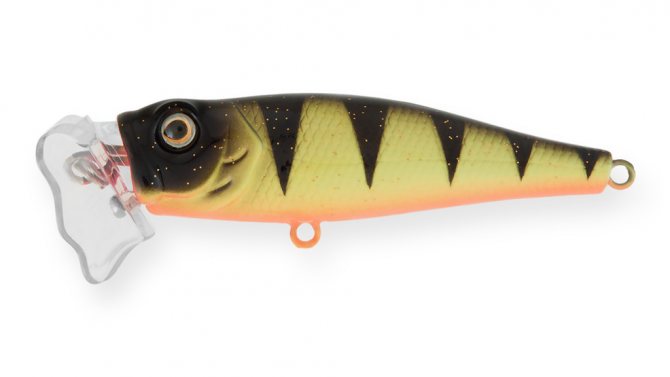
Jerk retrieval is the retrieval of the bait, which is carried out using the movements of the rod. The bait in the water moves jerkily, reminiscent of the movements of a weak, wounded fish. Jerk retrieves are used when fishing with lures that do not have their own active action. Jerking movements can tempt even a passive predator to attack.
Twitching
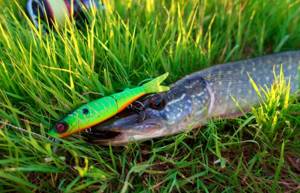
Twitching is a set and mixture of a wide variety of jerking wiring. When twitching, a combination of various stretches, jerks and pauses is used to attract the attention of the predator and provoke it to attack. Twitching is carried out using sharp and smooth movements of the rod.
Ripping
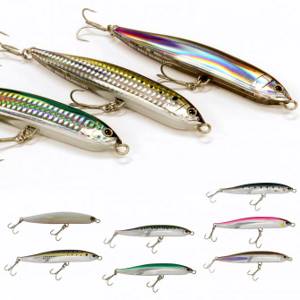
Ripping is the jerking of a spinning bait, similar to twitching and jerking. The name ripping comes from the English word rip, which translates as to rip open or gut. The movements of the rod when ripping are made from top to bottom and have a greater amplitude than with other types of jerking. The movement of the rod is indeed somewhat reminiscent of the movement of a knife when cutting a suspended carcass. After moving the rod, during a pause the angler winds the slack line onto the reel. When ripping, the wobbler usually goes deeper than when twitching and jerking.
Jerking
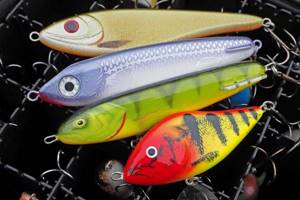
Jerking is a method of jerking a special type of bait - jerkbaits, which are also simply called jerks. At its core, jerking is twitching, but using jerkbaits. Jerkbaits are heavier baits than other wobblers. When fishing a jerk, they go at greater depths, which helps catch larger fish, which, as you know, often prefer to stay in deeper places.
Stop and go wiring
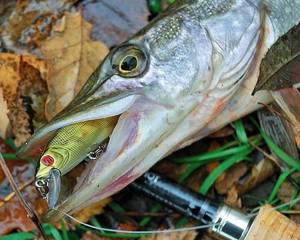
Stop & Go wiring is intermediate between uniform and jerking wiring. It is carried out by rotating the reel handle, which alternates with pauses. The “stop and go” wiring forces the wobbler to move underwater and hover in place, which well provokes a passive predator to attack the bait. Typically, “stop and go” wiring is performed as follows: cast the bait, make 4-5 turns of the reel, then pause for 2-3 seconds, a small jerk with the tip of the spinning rod, then the next 4-5 turns of the reel. Predator attacks on bait most often occur during a pause.
"Walk the Dog" wiring
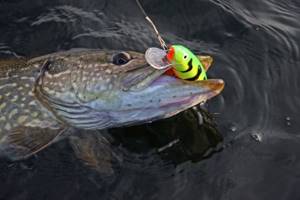
The “Walk the Dog” retrieve, which translated from English means “to walk the dog,” is used when fishing with surface lures, most often when fishing with walkers. The “Walk the Dog” wiring refers to jerking wiring; after splashing down the bait, it is carried out with small pulls, which alternate with pauses. The amplitude of the pulls and the duration of pauses are selected by the fisherman for specific fishing conditions.
Wobbler installation
Mounting a wobbler to a fishing line can be done in two ways: through a carabiner with a swivel and a leash, or by directly tying the wobbler to the fishing line.
A leash is necessary in those fishing areas where there is a possibility of a pike attacking the wobbler.
If the predator is in an active state, installing a wobbler does not play a big role. If the predator is in a passive state, the thickness of the fishing line, the thickness of the leader and the method of mounting the wobbler to the fishing line become important.
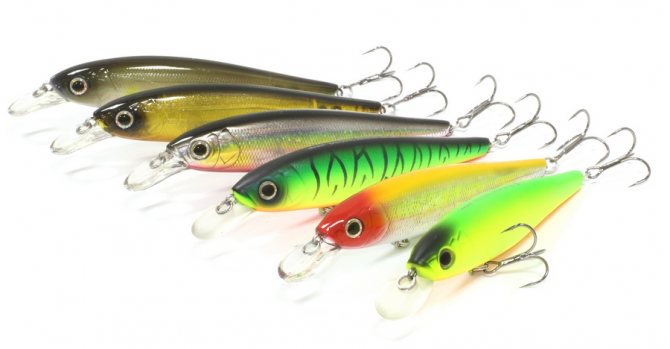
The method of mounting small-sized wobblers is especially important, since any element of the equipment can affect the performance of the wobbler. Medium and large wobblers are less susceptible to the influence of equipment on their game. The thinner the leash in front of the wobbler, the better it is for playing the wobbler.
When tying a wobbler directly to a fishing line, the wobbler plays much better than when mounted through a leash, but the downside of such fastening is the likelihood of the pike biting the line and losing the wobbler.
Many wobbler manufacturers recommend strictly defined types of knots for tying a wobbler to a fishing line or leash. The most famous of them:
- Rapala knot - recommended
- Double loop - recommended
- Improved clinch - recommended for use by the manufacturer of fluorocarbon fishing line "Kurekha" (Seaguar)
- Palomar is a universal knot suitable for tying any spinning bait to a fishing line
Decoding the symbols on wobblers
Most often, manufacturers of wobblers have the same designation system for characteristics and includes model, size, weight, buoyancy, operating depth range and color code.
Let's give a specific example. The wobbler says 60F-SR. This means that it has a length of 60 mm, its buoyancy type is floating (F), with surface recess (SR).
Over time, new types of wobblers appear. In order for them to be 100% useful when fishing, you need to arm yourself with a wealth of knowledge in the field of their application. In this case, fishing will bring an excellent catch and a feeling of satisfaction.
Views: 596
Similar articles:
- Catching pike with a wobbler Pike is a voracious river predator, which can be fished all year round...
- Top wobblers for pike. The best wobblers for pike fishing 2019-2020 A wobbler is a solid bait for fishing with a spinning rod or...
- Catching pike with wobblers in spring. Top 10 best spring wobblers Spring is a great time for fishing, especially for such a toothy...
- Fishing for pike by twitching. Top 5 best wobblers for twitching Twitching is a relatively new and quite effective fishing technique for…
